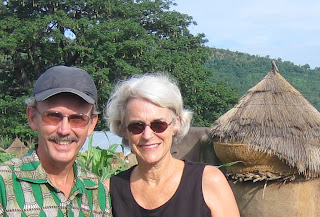Wednesday, March 29, at 9:15 a.m., Togo will experience what some say is one of the most awe inspiring spectacles in all of nature: A TOTAL SOLAR ECLIPSE. Atakpamé, our home town, is just about exactly in line for some of the best viewing of this event in the world. Good timing for us to be here!
In simple scientific terms a solar eclipse can be explained as: “An eclipse of the Sun can only occur at New Moon when the Moon passes between Earth and Sun. If the Moon’s shadow happens to fall upon Earth’s surface at that time, we see some portion of the Sun’s disk covered or “eclipsed” by the Moon.
More esthetically speaking, this total solar eclipse (which will only last a few minutes) can be described as: ”The sky takes on an eerie twilight as the Sun’s bright face is replaced by the black disk of the Moon. Surrounding the Moon is a beautiful gossamer halo. This is the Sun’s spectacular solar corona, a super heated plasma two million degrees in temperature. The corona can only be seen during the few brief minutes of totality. To witness such an event is a singularly memorable experience which cannot be conveyed adequately through words or photographs.” (That’s why we’re writing before the event…)
But to those Africans not “in the know,” the temporary morning darkness may cause panic. We’ve been told some people will think it is the end of the world, that what is happening is a war between the sun and the moon, and if either one should lose, obviously it’s not good. To combat the “war,” there will be noise-making: drumming and banging of basins throughout the town, pleading for the orbs to stop fighting. Schools will be closed for the day to minimize fears.
Lucky for us, Peace Corps Togo has supplied all the volunteers with special eclipse shades for viewing the eclipse without causing any permanent eye damage. Radio and TV broadcasts have started publicizing the event with cautions about eye damage. Locals have started talking about it rather excitedly, and pharmacies are now selling eclipse shades for about 60 cents, a big expense for an item used only once, and about the cost of one day of food for many people here.
How will we celebrate this event? We are planning a small party, serving a light brunch afterwards with the obvious menu choice: Eggs Sunny-Side Up.
If you feel like you are missing out on this grand event, you can look forward to the next two total solar eclipses visible from the US which will occur on August 21, 2017 and April 8, 2024.
If you are interested in finding out more, check out NASA’s technical web site:
http://sunearth.gsfc.nasa.gov
or for the layperson:
http://solar-eclipse-2006.info
No comments:
Post a Comment